|
|
History
| Indo-Greek Peshawar |
Gandharan Peshawar |
Arrival of Islam | Pashtun Kings
| Under British- Rule |
Durand Line |
Independence and Instability |
Culture | Peshawar Development Authority
| Educational Institutions |
Tourism | Transportation
| Media | Notable people
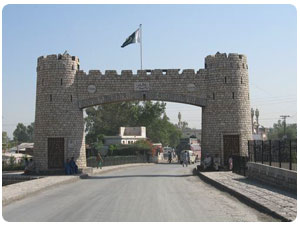 Peshāwar ( Pashto: پېښور Pekhawar / Peshawar, Hindko: پِشور Pishor, Urdu:
پشاور), is the capital of the North-West Frontier Province and the
administrative centre for the Federally Administered Tribal Areas of
Pakistan but not the capital of the federal regional territory. The Kushan
king Kanishka, moved the capital from Pushkalavati (now called Charsadda in
the Peshawar valley) to Purushapura in the 2nd century AD. The current name
"Peshawar" may derive from the Sanskrit Purushapura (meaning "city of men")
and is known as Pekhawar or Peshawar in Pashto and Pishor in Hindko. The
area originally belonged to Gandhara and the eastern Iranian tribes of
Scythian origin and later became part of the Kushan Empire empire. It gave
its name to the Peshwari naan bread, one of the diverse genres of naan
common in the curry houses of Great Britain. Briefly it also witnessed some
Greek influence after which it saw the Arab conquest and rise of Islam. It
then became one of the centers of Afghan empire. Today it is one of the
prime cities of Pakistan west of the river Indus Peshāwar ( Pashto: پېښور Pekhawar / Peshawar, Hindko: پِشور Pishor, Urdu:
پشاور), is the capital of the North-West Frontier Province and the
administrative centre for the Federally Administered Tribal Areas of
Pakistan but not the capital of the federal regional territory. The Kushan
king Kanishka, moved the capital from Pushkalavati (now called Charsadda in
the Peshawar valley) to Purushapura in the 2nd century AD. The current name
"Peshawar" may derive from the Sanskrit Purushapura (meaning "city of men")
and is known as Pekhawar or Peshawar in Pashto and Pishor in Hindko. The
area originally belonged to Gandhara and the eastern Iranian tribes of
Scythian origin and later became part of the Kushan Empire empire. It gave
its name to the Peshwari naan bread, one of the diverse genres of naan
common in the curry houses of Great Britain. Briefly it also witnessed some
Greek influence after which it saw the Arab conquest and rise of Islam. It
then became one of the centers of Afghan empire. Today it is one of the
prime cities of Pakistan west of the river Indus
Search Peshawar on
Satellite Map
Places of Interest
| Hotels |
Eating &
Dining | Parks &
Gardens |
Educational Institutes |
Hospitals |
Sport- Centers |
Banks |
ATM |
Fuel Stations |
CNG Stations |
Police Stations |
Shopping /Trade
History
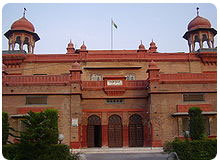 Peshawar is now officially recognised as being one of the Oldest Living
Cities in Asia. Its history and culture has continued uninterrupted since
several centuries. This fact was confirmed by the discovery of silver
punch-marked coins from the Government House in 1906-07 and the ongoing
excavation at Gor Khatri which is the deepest and widest in the world. Being
among the most ancient cities of the region between Central, South, and West
Asia, Peshawar has for centuries been a centre of trade between Afghanistan,
South Asia, Central Asia and the Middle East. As an ancient center of
learning, the 2nd century B.C.E. Bakhshali Manuscript used in the Bakhshali
approximation was found nearby.Peshawar is also the setting of the famous
story Peshawar Nights, which was an exchange between a Shia scholar and a
Sunni audience over the course of eleven nights, which presumably resulted
in their acceptance of Shi'ism. Peshawar is now officially recognised as being one of the Oldest Living
Cities in Asia. Its history and culture has continued uninterrupted since
several centuries. This fact was confirmed by the discovery of silver
punch-marked coins from the Government House in 1906-07 and the ongoing
excavation at Gor Khatri which is the deepest and widest in the world. Being
among the most ancient cities of the region between Central, South, and West
Asia, Peshawar has for centuries been a centre of trade between Afghanistan,
South Asia, Central Asia and the Middle East. As an ancient center of
learning, the 2nd century B.C.E. Bakhshali Manuscript used in the Bakhshali
approximation was found nearby.Peshawar is also the setting of the famous
story Peshawar Nights, which was an exchange between a Shia scholar and a
Sunni audience over the course of eleven nights, which presumably resulted
in their acceptance of Shi'ism.
Peshawar was a major center of Buddhist learning until the 10th century. As
an indication of its importance, Peshawar was also the site of Kanishka's
Great Stupa which housed relics of Gautama Buddha, and was widely considered
to be the tallest building in the world at the time of its construction.
Ancient Chinese manuscripts tell of Buddhist pilgrims such as Faxian, Sung
Yun, and Xuanzang reporting that the 7th century stupa, which was
rediscovered in the south east of the city at a site called Shahji-ki-Dheri
in 1907-08, had a height of 591–689 feet.
Peshawar emerged as a centre of both Hindko and Pashtun intellectuals. Its
dominant culture for much of British rule was that of the Hindko speakers,
also referred to as "Khaarian" ('city dwellers' in Pashto).Its unique
culture, distinct from the surrounding Pashtun areas, led to the city being
romanticised by Pashto singers, with songs like larsha Pekhwar tha (let us
go to Peshawar) and more recently Pekhawar kho pekhawar dhay kana. This
unique culture has gradually disappeared with the massive influx of Afghan
refugees and the increasing migration of Pashtuns into the city. The
demographics has changed quite dramatically and Pashto is now the dominant
language of the city.
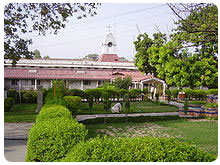 Peshawar is located in an area that was dominated by various tribes of
Indo-Iranian origin. The region was affiliated with the ancient kingdom of
Gandhara and had links to the Harappan civilization of the Indus River
Valley and to Bactria and other ancient kingdoms based in Afghanistan.
According to the historian Tertius Chandler, Peshawar had a population of
120,000 in the year 100 BCE, making it the seventh most populous city in the
world. Peshawar is located in an area that was dominated by various tribes of
Indo-Iranian origin. The region was affiliated with the ancient kingdom of
Gandhara and had links to the Harappan civilization of the Indus River
Valley and to Bactria and other ancient kingdoms based in Afghanistan.
According to the historian Tertius Chandler, Peshawar had a population of
120,000 in the year 100 BCE, making it the seventh most populous city in the
world.
Vedic mythology refers to an ancient settlement called Pushkalavati in the
area, after Pushkal, the son of King Bharata in the epic Ramayana, but this
settlement's existence remains speculative and unverifiable.In recorded
history, the earliest major city established in the general area of Peshawar
was called Purushapura (Sanskrit for City of Men) and was founded by the
Kushans, a Central Asian tribe of Tocharian origin, over 2,000 years ago.
Prior to this period the region was affiliated with Gandhara, an ancient
Indo-Iranian kingdom, and was annexed first by the Persian Achaemenid empire
and then by the Hellenic empire of Alexander the Great. The city passed into
the rule of Alexander's successor, Seleucus I Nicator who ceded it to
Chandragupta Maurya, the founder of the Maurya Empire in 305 BCE. Buddhism
was introduced into the region at this time and may have claimed the
majority of Peshawar's inhabitants before the coming of Islam
Go To Top
Indo-Greek Peshawar
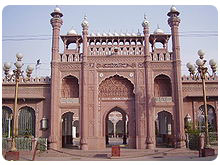 The area that Peshawar occupies was then seized by the Greco-Bactrian king,
Eucratides (170 - 159 BCE), and was controlled by a series of Greco-Bactrian
and later Indo-Greek kings who ruled an empire that spanned from present day
Pakistan to North India. Later, the city came under the rule of several
Parthian and Indo-Parthian kings, another group of Iranic invaders from
Central Asia, the most famous of whom, Gondophares, ruled the city and its
environs starting in circa 46 CE, and was briefly followed by two or three
of his descendants before they were displaced by the first of the "Great
Kushans", Kujula Kadphises, around the middle of the 1st century CE The area that Peshawar occupies was then seized by the Greco-Bactrian king,
Eucratides (170 - 159 BCE), and was controlled by a series of Greco-Bactrian
and later Indo-Greek kings who ruled an empire that spanned from present day
Pakistan to North India. Later, the city came under the rule of several
Parthian and Indo-Parthian kings, another group of Iranic invaders from
Central Asia, the most famous of whom, Gondophares, ruled the city and its
environs starting in circa 46 CE, and was briefly followed by two or three
of his descendants before they were displaced by the first of the "Great
Kushans", Kujula Kadphises, around the middle of the 1st century CE
Go To Top
Gandharan Peshawar
Peshawar formed the eastern capital of the empire of Gandhara under the
Kushan king Kanishka, who reigned from at least 127 CE. Peshawar became a
great centre of Buddhist learning. Kanishka built what may have been the
tallest building in the world at the time, a giant stupa, to house the
Buddha's relics, just outside the Ganj Gate of the old city of Peshawar.
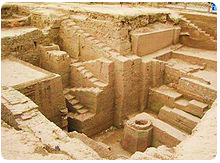 The Kanishka stupa was said to be an imposing structure as one travelled
down from the mountains of Afghanistan onto the Gandharan plains. The
earliest account of the famous building is by the Chinese Buddhist pilgrim
monk, Faxian, who visited it in 400 and described it as being over 40 chang
in height (probably about 120 m or 394 ft) and adorned "with all precious
substances". "Of all the stûpas and temples seen by the travellers, none can
compare with this for beauty of form and strength." It was destroyed by
lightning and repaired several times. It was still in existence at the time
of Xuanzang's visit in 634. From the ruined base of this giant stupa there
existed a jewelled casket containing relics of the Buddha, and an
inscription identifying Kanishka as the donor, and was excavated from a
chamber under the very centre of the stupa's base, by a team under Dr. D.B.
Spooner in 1909. The stupa was roughly cruciform in shape with a diameter of
286 feet (87 meters) and heavily decorated around the sides with stucco
scenes. The Kanishka stupa was said to be an imposing structure as one travelled
down from the mountains of Afghanistan onto the Gandharan plains. The
earliest account of the famous building is by the Chinese Buddhist pilgrim
monk, Faxian, who visited it in 400 and described it as being over 40 chang
in height (probably about 120 m or 394 ft) and adorned "with all precious
substances". "Of all the stûpas and temples seen by the travellers, none can
compare with this for beauty of form and strength." It was destroyed by
lightning and repaired several times. It was still in existence at the time
of Xuanzang's visit in 634. From the ruined base of this giant stupa there
existed a jewelled casket containing relics of the Buddha, and an
inscription identifying Kanishka as the donor, and was excavated from a
chamber under the very centre of the stupa's base, by a team under Dr. D.B.
Spooner in 1909. The stupa was roughly cruciform in shape with a diameter of
286 feet (87 meters) and heavily decorated around the sides with stucco
scenes.
Sometime in the 1st millennium BCE, the group that now dominates Peshawar
began to arrive from the Suleiman Mountains of southern Afghanistan to the
southwest, the Pashtuns. Over the centuries the Pashtuns would come to
dominate the region and Peshawar has emerged as an important center of
Pashtun culture along with Kandahar and Kabul as well as Quetta in more
recent times. Muslim Arab and Turkic arrived and annexed the region before
the beginning of the 2nd millennium.
Go To Top
Arrival of Islam
The Pashtuns began to convert to Islam following early annexation by the
Arab Empire from Khurasan (in what is today western Afghanistan and
northeastern Iran).
“ Sebuktagin dying in 997 was succeeded as governor of Khorasan by his son
Mahmud, who throwing off all dependence on the Samani princes, assumed
the title of Sultan in 999, and from this reign the Hindu religion in these
parts may be said to have received a death blow. In the early reign of this
celebrated invader of India the plains of Peshawar were again the scene of
some great battles, the first of which was fought on the maira between
Nowshera and the Indus, in the year 1001. Mahmud was opposed by Jaipal, who
had been constantly endevouring to recover the country wrested from him by
Sebuktagin, still aided by some Pathans whose allegiance to the Muslim
governor of Peshawar was not of long continuance.
The battle took place on November 27 and the Hindus were one again routed,
Jaipal himself being taken prisoner, who upon his subsequent release
resigned the crown to his son Anandpal. On this occasion Mahmud punished the
Pathans who had sided with the enemy, and as they were now converted
entirely to the Islam, they stayed true to their new allegiance, and joined
the Sultan in his wars against the infidels
Peshawar was taken by Turkic Muslims in 988 and was incorporated into the
larger Mughal domains by the 16th century. The founder of the Mughul dynasty
that would conquer South Asia, Babur, who hailed from current Uzbekistan,
came to Peshawar and founded a city called Bagram where he rebuilt the fort
in 1530. His grandson, Akbar, formally named the city Peshawar, meaning "The
Place at the Frontier" in Persian and expanded the bazaars and
fortifications. The Muslim technocrat, bureaucrats, soldiers, traders,
scientists, architects, teachers, theologians and Sufis flocked from the
rest of the Muslim world to Islamic Sultanate in South Asia and many settled
in the Peshawar region
Go To Top Reigns of the
Pashtun Kings
 The Pashtun conqueror Sher Shah Suri, turned Peshawar's renaissance into a
boom when he ran his Delhi-to-Kabul Shahi Road through the Khyber Pass and
Peshawar. Thus the Mughals turned Peshawar into a "City of Flowers" by
planting trees and laying out gardens similar to those found to the west in
Iran. Khushal Khan Khattak, the Pashtun/Afghan warrior poet, was born near
Peshawar and his life was intimately tied to the city. Khattak was an early
Pashtun nationalist, who agitated for an independent Afghanistan including
Peshawar. As such, he was an implacable foe of the Mughal rulers, especially
Aurangzeb. The Pashtun conqueror Sher Shah Suri, turned Peshawar's renaissance into a
boom when he ran his Delhi-to-Kabul Shahi Road through the Khyber Pass and
Peshawar. Thus the Mughals turned Peshawar into a "City of Flowers" by
planting trees and laying out gardens similar to those found to the west in
Iran. Khushal Khan Khattak, the Pashtun/Afghan warrior poet, was born near
Peshawar and his life was intimately tied to the city. Khattak was an early
Pashtun nationalist, who agitated for an independent Afghanistan including
Peshawar. As such, he was an implacable foe of the Mughal rulers, especially
Aurangzeb.
After the decline of the Mughal Empire, by the 18th century the city came
under Persian control during the reign of Nadir Shah. In 1747, following a
loya jirga, Peshawar would join the Afghan/Pashtun empire of Ahmad Shah
Durrani as a Pakthun region. Pashtuns from Peshawar took part in the
incursions of South Asia during the rule of Ahmad Shah Durrani and his
successors
Go To Top Peshawar
Under British Rule
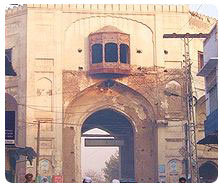 In 1812, Peshawar was on the edge of Afghan controlled territory, but
threatened by the Sikhs. The arrival of a party led by British explorer and
former agent of the East India Company, William Moorcroft was seen as an
advantage, both in dealings with Kabul and in protection against the Sikhs
of Lahore. He was even offered the governership of Peshawar and invited to
offer the area's allegiance to the East India Company, which he declined.
Moorcroft continued to Kabul in the company of Peshwari forces and thence to
the Hindu Kush. In 1812, Peshawar was on the edge of Afghan controlled territory, but
threatened by the Sikhs. The arrival of a party led by British explorer and
former agent of the East India Company, William Moorcroft was seen as an
advantage, both in dealings with Kabul and in protection against the Sikhs
of Lahore. He was even offered the governership of Peshawar and invited to
offer the area's allegiance to the East India Company, which he declined.
Moorcroft continued to Kabul in the company of Peshwari forces and thence to
the Hindu Kush.
Sikh rule of the city was disastrous for the city, many of its gardens and
monuments were destroyed. The city's population dwindled to half of what it
was. With the collapse of the Sikh Empire, following the death of Maharaja
Ranjit Singh and the Sikh defeat in the second Anglo-Sikh War, the British
occupied Peshawar in 1849.
The mountainous areas outside of the city were mapped out in 1893 by Sir
Mortimer Durand, then foreign secretary of the British Indian government,
who demarcated the boundary of his colony with the Afghan ruler at the time,
Abdur Rahman Khan. It is now known as the Durand Line. The Kabul government
has argued that the pact expired when British colonialists left the region -
although claims to the region have not been a part of official Afghan policy
Go To Top
Durand Line
In 1893, Mortimer Durand negotiated with Abdur Rahman Khan the Amir of
Afghanistan , the frontier between Afghanistan, the FATA , North-West
Frontier Province and Baluchistan Provinces of Pakistan, the successor state
of British India, and Afghanistan.
This line, the Durand Line, is named after Sir Mortimer Durand and remains
the international boundary between Afghanistan and modern-day Pakistan,
officially recognized by most nations but and ongoing point of contention
between the two countries.
In 1893, Sir Mortimer Durand was deputed to Kabul by the government of
British India for this purpose of settling an exchange of territory required
by the demarcation of the boundary between northeastern Afghanistan and the
Russian possessions, and in order to discuss with the Amir Abdur Rahman Khan
other pending questions. The Amir showed his ability in diplomatic argument,
his tenacity where his own views or claims were in debate, with a sure
underlying insight into the real situation.
The territorial exchanges were amicably agreed upon; the relations between
the British Indian and Afghan governments, as previously arranged, were
confirmed; and an understanding was reached upon the important and difficult
subject of the border line of Afghanistan on the east, towards India.
In 1893 during rule of Amir Abdur Rahman Khan of Afghanistan a "Royal
Commission for setting up of Boundary" the Durand Line between Afghanistan
and the British-governed India was set up, to negotiate terms with the
British, for the Agreeing to the Durand line , and the two parties camped at
Parachinar, now part of FATA Pakistan, which is near Khost Afghanistan.
From the British side the camp was attended by Sir Mortimer Durand and
Sahibzada Abdul Qayyum, Political Agent Khyber.
The Afghanistan side was represented by Sahibzada Abdul Latif and the
Governor KhostSardar Shireendil Khan representing the Amir.
Go To Top
Independence and Instability
In 1947, Peshawar became part of the newly independent state of Pakistan
after politicians from the Frontier approved merger into the state that had
just been carved from British India. While a large majority of people
approved of this action, others believed in the unity of India, such as
Abdul Ghaffar Khan. Still others believed that the province should have
ascended to Afghanistan - a position which later evolved into a call for a
state independent of both Pakistan and Afghanistan.
Until the mid-1950s, Peshawar was enclosed within a city wall and sixteen
gates. Of the old city gates, the most famous was the Kabuli Gate but only
the name remains to this date. Peshawar has not grown as much in size or
capacity as the population has. As a result it has become a polluted and
overcrowded city.
During the 1980s Soviet war in Afghanistan, Peshawar served as a political
centre for the Inter-Services Intelligence-trained mujahideen groups, and
housed Afghan refugees at the Jalozai refugee camp. There were a total of
about 100,000 Afghan refugees reported in Peshawar during the 1988 election
when Benazir Bhutto was running for Prime Minister of Pakistan.Peshawar
managed to assimilate many of the ethnic Pashtun Afghans with relative ease
and many of them still remain in Pakistan.
Peshawar continues to be a city that links Pakistan with Afghanistan as well
as Central Asia, and has emerged as an important regional city in Pakistan.
It remains a focal point for Pashtun culture. Today, like the surrounding
region, it is at the crossroads of the struggle between the extremist
Taliban and moderates, liberals and Pashtun nationalists. As a demonstration
of their determination to destroy Pashtun icons, the Taliban bombed the
shrine of the most beloved Pashtun poet, Rahman Baba, in 2009
Find more about
History of Pakistan
Go To Top
Culture
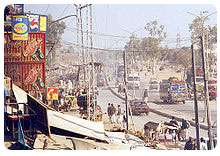 Peshawar is the centre of Pashtun culture and arts in Pakistan. With the
Soviet war in Afghanistan in the 1980s and the influx of Afghan refugees
into Pakistan, Peshawar became home for many Afghan musicians and artists.
The city has become the centre for Pashto music and cinema as well Persian
music for the Tajiks. There is also a thriving book publishing activity in
the Persian language in Peshawar, concentrated primarily on Islamic Shia
literature and located in the Qissa Khawani Bazaar where it is operated by
Shia Hindkowaan. Peshawar is the centre of Pashtun culture and arts in Pakistan. With the
Soviet war in Afghanistan in the 1980s and the influx of Afghan refugees
into Pakistan, Peshawar became home for many Afghan musicians and artists.
The city has become the centre for Pashto music and cinema as well Persian
music for the Tajiks. There is also a thriving book publishing activity in
the Persian language in Peshawar, concentrated primarily on Islamic Shia
literature and located in the Qissa Khawani Bazaar where it is operated by
Shia Hindkowaan.
However, the election of the Muttahida Majlis-e-Amal (MMA) Islamic coalition
in 2002 resulted in restrictions on public musical performances, as well as
a ban on playing recorded music on public transports. Peshawar has become
host to a thriving underground scene. In 2008, the secular Awami National
Party (ANP) swept elections and won power from the Islamic coalition. Since
then, some restrictions have been lifted, but there has not been a full
restoration of the liberties guaranteed before the MMA victory in 2002.
The historic old city of Peshawar was once a heavily guarded citadel with
high walls. Today, not much remains of the walls, but the houses and havelis
have an essence of days gone by. Most of the houses are made of unbaked
bricks with wooden structures for protection against earthquakes. Many of
them have beautifully carved wooden doors and latticed wooden balconies.
Areas such as Sethi Mohallah still contain many fine examples of the old
architecture of Peshawar. There are many historic monuments and bazaars in
the Old city, including the Mohabbat Khan Mosque and Kotla Mohsin Khan,
Chowk Yadgar and the Qissa Khawani Bazaar.
The walled city was surrounded by several main gates which severed as the
main entry points into the city, some of which still survive today. They
include: Lahori Gate, Sarasia Gate, Ganj Gate, Sirki Gate, Sard Chah Gate,
Kohati Gate Former Gates which were demolished during wars were Kabuli Gate,
Berikian Gate, Bajori Gate, Yakatut Gate, Dabgari Gate, Kachahri Gate, and
Hasht Nagri Gate
Find more about
Culture of Pakistan ,
People, Art & Culture
Go To Top
Peshawar Development Authority
Peshawar Development Authority (PDA) is the department in charge of
construction in Peshawar. This includes roads, parks, and plant life.
The department (CD&MD) was renewed because of the immense corruption which
had taken place before.Its first Director General was Malik Saad.The then
governor Lt. Gen Iftikhar Hussain Shah specifically requested Malik Saad to
help tackle the corruption and bring the department back up to its former
success again.This decision proved successful, because not only was the
corruption tackled, but also the city`s development was in full gear and the
city`s only fully functional flyover,also named after Malik Saad, was built
along with many other projects and developments in the city.
Nimak Mandai is the central selling point for cooked meat and is famous
throughout Pakistan
Go To Top
Educational Institutions
Satellite View of Educational institutes
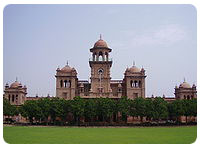 With the level of higher education on the rise, there has been a surge
[citation needed] of prestigious educational institutions in Peshawar. The
prestigious University of Peshawar (UOP) was established in October 1950 by
the first Prime Minister of Pakistan in Peshawar. Edwardes College which was
founded in 1900 by Herbert Edwardes is the oldest and one of the finest
colleges in the province. The Islamia College was founded in 1913 and is
also a well known institution. With the level of higher education on the rise, there has been a surge
[citation needed] of prestigious educational institutions in Peshawar. The
prestigious University of Peshawar (UOP) was established in October 1950 by
the first Prime Minister of Pakistan in Peshawar. Edwardes College which was
founded in 1900 by Herbert Edwardes is the oldest and one of the finest
colleges in the province. The Islamia College was founded in 1913 and is
also a well known institution.
Find more about
Worldwide Education
Go To Top
Tourism
Peshawar is one of the oldest cities of the world[citation needed]. It is a
conservative Islamic city with a rich history. It offers everything from
goldsmiths and silversmiths, traditional carpets (one of the big exports of
Pakistan today), pottery, and clothing to artwork in wood, brass or
semi-precious stones. The old walled city was known for its 16 gates —
Bijouri, Kabuli, Aasamai, Kutcheri, Rampura, Hasht Nagri, Toot, Kohati,
Sirki, Thandi Khoi, Barzaqan, Ganj, Ramdas, Dabgari, and Lahore Gate. The
names given to these gates are significant. It was Sikh General Avitabile
who built a mud wall surrounding the city.[29] Under the British nearly the
whole of the enclosure wall had been built of pucca brick.[30] There are
many bazaars with different goods and souvenirs for travellers. The main
ones include the historic Qissa Khawani Bazaar, the Copper market, Chowk
Yadgar and Andarsheher Bazaar. In addition because of its access to the
Khyber pass, the Khyber train safari starts from here.
General
Governor's House
Mattani
Deans Trade Center
Peshawar Garrison Club
Aviator's Station - The site where freedom fighters of the 1857 independence
movement were blown from guns.
Danish Abad and Board Bazaar
Hayatabad
Kotla Mohsin Khan - The residence of Mazullah Khan, seventeenth century
Pashtu poet.
Durrani Graveyard
Sethi Mohallah
Garhi Qamardin
Palosi - A famous village situated on the back of Agricultural University
Peshawar. It is subdivided into four parts called as Piran, Attozai,
Maghdarzai, and Turlazai.
Forts
Bala Hisar Fort
Burj Hari Singh - Sikh fort founded by Sikh General Sardar Hari Singh Nalwa
(no longer exists)
Colonial M0onuments
Bara Bridge built by Mughal rulers in 1629.
Chowk Yadgar - Formerly Hastings memorial
Cunningham clock tower built in 1900. Called Ghanta Ghar
Avitabile's Pavilion
Edwardes School - The residence of Yar Mohammad Khan, the last Durrani
Governor of Peshawar
Buddhist
Gor Khuttree - An ancient site of Buddha's alms or begging bowl. Headquarter
of Syed Ahmad Shaheed, Governor Avitabile
Pashto Academy - The site of an ancient Buddhist University
Shah Ji Ki Dheri - The site of Kanishka's famous Buddhist monastery.
Hindu
Panch Tirath - An ancient Hindu site now converted into a park
Sikh
Sikh Gurudwara at Jogan Shah
Mausoleums
Tomb of Sheikh Imamuddin (d.1650) at Palosi Piran.
Tomb of Rahman Baba (d.1706)
Tomb of Akhund Darweza (d.1638)
Tomb of Sheikh Sultan Baba
Mausoleum of Nawab Sayed Khan
Ziarat of Ashab Baba
Burj-e-Roshnai
Parks
Army Stadium - Amusement Park for children and families with restaurants,
banks, play pans and shopping arcade.
Cunningham Park/Jinnah Park- Situated opposite Historic Bala Hisar Fort,
close to Asamai Gate and Lady Reading Hospital.
Wazir Bagh - Laid in 1802, by Fatteh Khan, Prime Minister of Shah Mahmud
Khan.
Ali Mardan Khan Gardens - Formerly Company Bagh now Khalid bin Waleed Park.
Shahi Bagh - A small portion of which constitutes the current site of Arbab
Niaz Stadium.
Garrison Park - Located at Prime Location of Shami Road under Army Control.
Tatara Park - Located in Hayatabad for children and families.
Mosques
Mohabbat Khan Mosque
Ganj Ali Khan Mosque
Qasim Ali Khan Mosque
Sonehri Masjid
Zarghooni MOsque
Bilal Masjid Shami Road.
Museums
Peshawar Museum (Victoria Memorial Hall)
Agha Khan Museum, Peshawar University
Shopping
Gul Haji Plaza
Qissa Khawani Bazaar
Karkhano Market
Deans Trade Centre
Jans Arcade
Imperial Stores
City Towers
Jawad Towers
Town Towers
Saddar
Bazar
Mall Towers
University road
Hotels
Pearl Continental
Khan Klub
Grand Hotel
Marhaba Hotel
Hidayat Hotel
North West
Heritage Hotel
Coffee Bars, Cafes and Restaurants
Masooms Cafe
Cafe De'Viento
Cafe De'Milan
Namak Mandi
Charsi
Tikka Shop
Potato- Plus
SS Club
Chief Pizzas and Burgers
KFC
Pizza Hut
Four Seasons
Shiraz Restaurants
Find more about
Travel and Tourism Pakistan
, Worldwide Travel
& Tourism
Go To Top
Transportation
The Peshawar International Airport serves the city and the province of the
North-West Frontier as the main international airport in the region. It is
served by all airlines of Pakistan as well as many major airlines including
Emirates and Qatar Airways who have regular flights to the Persian Gulf and
forward connections to Europe. The city is linked to the main motorway as
well as the Karakorum Highway from which it is connected to all of the major
cities of Pakistan including Karachi, Lahore, Islamabad, Rawalpindi,
Faisalabad and Multan. The roads are also linked to Afghanistan and China.
Afghanistan is linked through the Khyber Pass, which is the main gateway for
both cargo and passenger travel. In the city, there are all sorts of methods
to travel around, from coaches, buses, rickshaws, auto rickshaws, yellow and
black taxis, to traditional methods such as horse and carts. Peshawar
Railway Station is run by Pakistan Railways, the largest operator of rail
companies in Pakistan, with connections to all parts of Pakistan as well as
Afghanistan.
Go To Top
Media
Media & News in Pakistan
Being the capital city for the Pashto and Paktuns, Peshawar is a focal point
for various literature, political and media related personalities. Aaj Daily
is one of many newspapers published from the city. The city also hosts its
own film industry, Pollywood, where countless Pashto films have been made.
Men of Letters include, Farigh Bukhari, Raza Hamadani, Mohsin Ihsan, Khatir
Ghaznavi, Taaha Khan, Zahoor Awan, Taj Saeed, Zaitoon Bano, Sajjad Babar,
Nazeer Tabassum, Malik Nasir Ali Nasir, Qasim Hasrat, Majid Sarhadi, Younus
Qiasi, Nasir Ali Sayed, Amjad Hussain Muhammad Hashim Babar
Find more about
Worldwide Media & News
Go To Top
Notable people
Abdul Wahid Yousafi - Journalist Pride of Performance
Abdur Rab Nishtar - Muslim religious leader
Agha Mir Abbas [1907-37] Businessman/Poet
A. K. Hangal - Indian film actor
Badshah Munir Bukhari - Linguist
DIG Malik Saad - Highly decorated senior police officer. Former Chief
Capital City police officer; martyred in suicide bombing on January 27,
2007. Recipient of Nishan-i-Shujaat; highest civilian award for bravery.
Justice (Rtd) Khan Habibullah Khan Marwat (1901-78) Meenakhel by origin,
educated at Islamia College Peshawar, Edwardes College Peshawar, ALIGARH
MUSLIM UNIVERSITY. Justice of West Pakistan High Court, first & second
Chairman of the Senate of Pakistan. Acting President of Pakistan when
President Fazal Ilahi Chaudhry went abroad. Pakistan's Interior Minister and
also Chief Minister of West Pakistan (One Unit). Elected to the first
Legislative Council of NWFP (1932) first as a member and later Deputy
Speaker.
Anwar Kamal Khan Marwat is a MeenaKhel by origin and former Member of
Provincial Assembly as well as former Provincial Minister and Senator.
Currently General Secretary PML (N) NWFP.
Dilip Kumar - Indian film actor
Ismail Gulgee - Pakistani artist
Jansher Khan - Squash player and several times world champion
Khan Abdul Ghaffar Khan - Pakistani politician/political leader
Khan Abdul Ghani Khan - Pakistani poet & philosopher
Khushal Khan Khattak - Pashto poet
Mir Sajjad Hussein Kazmi [1933-92] educator
Mulk Raj Anand - Writer in English
Patras Bokhari, Urdu scholar, humorist, educator, essayist, broadcaster and
diplomat
Raheem Shah - Pakistani singer
Rahimullah Yusufzai- Journalist
Rahman Baba - Pashto poet
Raj Kapoor - Indian film actor
Rangeela - Pakistani film actor
Umer Gul - Cricket player
Vinod Khanna - Indian superstar
Yasir Hamid - Cricket player
Amjad Khan
Prithviraj Kapoor
Hashim Khan
Jahangir Khan
Shahid Afridi
Younis Khan
Shahrukh khan - Indian actor, migrated from Peshawar to Delhi
Syed Askar Ali Shah-NWFP - Police, journalist
Thakur Das - Lawyer
Najibullah Zazi - Convicted al-Qaeda member
Go To Top |




 Peshāwar ( Pashto: پېښور Pekhawar / Peshawar, Hindko: پِشور Pishor, Urdu:
پشاور), is the capital of the North-West Frontier Province and the
administrative centre for the Federally Administered Tribal Areas of
Pakistan but not the capital of the federal regional territory. The Kushan
king Kanishka, moved the capital from Pushkalavati (now called Charsadda in
the Peshawar valley) to Purushapura in the 2nd century AD. The current name
"Peshawar" may derive from the Sanskrit Purushapura (meaning "city of men")
and is known as Pekhawar or Peshawar in Pashto and Pishor in Hindko. The
area originally belonged to Gandhara and the eastern Iranian tribes of
Scythian origin and later became part of the Kushan Empire empire. It gave
its name to the Peshwari naan bread, one of the diverse genres of naan
common in the curry houses of Great Britain. Briefly it also witnessed some
Greek influence after which it saw the Arab conquest and rise of Islam. It
then became one of the centers of Afghan empire. Today it is one of the
prime cities of Pakistan west of the river Indus
Peshāwar ( Pashto: پېښور Pekhawar / Peshawar, Hindko: پِشور Pishor, Urdu:
پشاور), is the capital of the North-West Frontier Province and the
administrative centre for the Federally Administered Tribal Areas of
Pakistan but not the capital of the federal regional territory. The Kushan
king Kanishka, moved the capital from Pushkalavati (now called Charsadda in
the Peshawar valley) to Purushapura in the 2nd century AD. The current name
"Peshawar" may derive from the Sanskrit Purushapura (meaning "city of men")
and is known as Pekhawar or Peshawar in Pashto and Pishor in Hindko. The
area originally belonged to Gandhara and the eastern Iranian tribes of
Scythian origin and later became part of the Kushan Empire empire. It gave
its name to the Peshwari naan bread, one of the diverse genres of naan
common in the curry houses of Great Britain. Briefly it also witnessed some
Greek influence after which it saw the Arab conquest and rise of Islam. It
then became one of the centers of Afghan empire. Today it is one of the
prime cities of Pakistan west of the river Indus Peshawar is now officially recognised as being one of the Oldest Living
Cities in Asia. Its history and culture has continued uninterrupted since
several centuries. This fact was confirmed by the discovery of silver
punch-marked coins from the Government House in 1906-07 and the ongoing
excavation at Gor Khatri which is the deepest and widest in the world. Being
among the most ancient cities of the region between Central, South, and West
Asia, Peshawar has for centuries been a centre of trade between Afghanistan,
South Asia, Central Asia and the Middle East. As an ancient center of
learning, the 2nd century B.C.E. Bakhshali Manuscript used in the Bakhshali
approximation was found nearby.Peshawar is also the setting of the famous
story Peshawar Nights, which was an exchange between a Shia scholar and a
Sunni audience over the course of eleven nights, which presumably resulted
in their acceptance of Shi'ism.
Peshawar is now officially recognised as being one of the Oldest Living
Cities in Asia. Its history and culture has continued uninterrupted since
several centuries. This fact was confirmed by the discovery of silver
punch-marked coins from the Government House in 1906-07 and the ongoing
excavation at Gor Khatri which is the deepest and widest in the world. Being
among the most ancient cities of the region between Central, South, and West
Asia, Peshawar has for centuries been a centre of trade between Afghanistan,
South Asia, Central Asia and the Middle East. As an ancient center of
learning, the 2nd century B.C.E. Bakhshali Manuscript used in the Bakhshali
approximation was found nearby.Peshawar is also the setting of the famous
story Peshawar Nights, which was an exchange between a Shia scholar and a
Sunni audience over the course of eleven nights, which presumably resulted
in their acceptance of Shi'ism. Peshawar is located in an area that was dominated by various tribes of
Indo-Iranian origin. The region was affiliated with the ancient kingdom of
Gandhara and had links to the Harappan civilization of the Indus River
Valley and to Bactria and other ancient kingdoms based in Afghanistan.
According to the historian Tertius Chandler, Peshawar had a population of
120,000 in the year 100 BCE, making it the seventh most populous city in the
world.
Peshawar is located in an area that was dominated by various tribes of
Indo-Iranian origin. The region was affiliated with the ancient kingdom of
Gandhara and had links to the Harappan civilization of the Indus River
Valley and to Bactria and other ancient kingdoms based in Afghanistan.
According to the historian Tertius Chandler, Peshawar had a population of
120,000 in the year 100 BCE, making it the seventh most populous city in the
world. The area that Peshawar occupies was then seized by the Greco-Bactrian king,
Eucratides (170 - 159 BCE), and was controlled by a series of Greco-Bactrian
and later Indo-Greek kings who ruled an empire that spanned from present day
Pakistan to North India. Later, the city came under the rule of several
Parthian and Indo-Parthian kings, another group of Iranic invaders from
Central Asia, the most famous of whom, Gondophares, ruled the city and its
environs starting in circa 46 CE, and was briefly followed by two or three
of his descendants before they were displaced by the first of the "Great
Kushans", Kujula Kadphises, around the middle of the 1st century CE
The area that Peshawar occupies was then seized by the Greco-Bactrian king,
Eucratides (170 - 159 BCE), and was controlled by a series of Greco-Bactrian
and later Indo-Greek kings who ruled an empire that spanned from present day
Pakistan to North India. Later, the city came under the rule of several
Parthian and Indo-Parthian kings, another group of Iranic invaders from
Central Asia, the most famous of whom, Gondophares, ruled the city and its
environs starting in circa 46 CE, and was briefly followed by two or three
of his descendants before they were displaced by the first of the "Great
Kushans", Kujula Kadphises, around the middle of the 1st century CE The Kanishka stupa was said to be an imposing structure as one travelled
down from the mountains of Afghanistan onto the Gandharan plains. The
earliest account of the famous building is by the Chinese Buddhist pilgrim
monk, Faxian, who visited it in 400 and described it as being over 40 chang
in height (probably about 120 m or 394 ft) and adorned "with all precious
substances". "Of all the stûpas and temples seen by the travellers, none can
compare with this for beauty of form and strength." It was destroyed by
lightning and repaired several times. It was still in existence at the time
of Xuanzang's visit in 634. From the ruined base of this giant stupa there
existed a jewelled casket containing relics of the Buddha, and an
inscription identifying Kanishka as the donor, and was excavated from a
chamber under the very centre of the stupa's base, by a team under Dr. D.B.
Spooner in 1909. The stupa was roughly cruciform in shape with a diameter of
286 feet (87 meters) and heavily decorated around the sides with stucco
scenes.
The Kanishka stupa was said to be an imposing structure as one travelled
down from the mountains of Afghanistan onto the Gandharan plains. The
earliest account of the famous building is by the Chinese Buddhist pilgrim
monk, Faxian, who visited it in 400 and described it as being over 40 chang
in height (probably about 120 m or 394 ft) and adorned "with all precious
substances". "Of all the stûpas and temples seen by the travellers, none can
compare with this for beauty of form and strength." It was destroyed by
lightning and repaired several times. It was still in existence at the time
of Xuanzang's visit in 634. From the ruined base of this giant stupa there
existed a jewelled casket containing relics of the Buddha, and an
inscription identifying Kanishka as the donor, and was excavated from a
chamber under the very centre of the stupa's base, by a team under Dr. D.B.
Spooner in 1909. The stupa was roughly cruciform in shape with a diameter of
286 feet (87 meters) and heavily decorated around the sides with stucco
scenes. The Pashtun conqueror Sher Shah Suri, turned Peshawar's renaissance into a
boom when he ran his Delhi-to-Kabul Shahi Road through the Khyber Pass and
Peshawar. Thus the Mughals turned Peshawar into a "City of Flowers" by
planting trees and laying out gardens similar to those found to the west in
Iran. Khushal Khan Khattak, the Pashtun/Afghan warrior poet, was born near
Peshawar and his life was intimately tied to the city. Khattak was an early
Pashtun nationalist, who agitated for an independent Afghanistan including
Peshawar. As such, he was an implacable foe of the Mughal rulers, especially
Aurangzeb.
The Pashtun conqueror Sher Shah Suri, turned Peshawar's renaissance into a
boom when he ran his Delhi-to-Kabul Shahi Road through the Khyber Pass and
Peshawar. Thus the Mughals turned Peshawar into a "City of Flowers" by
planting trees and laying out gardens similar to those found to the west in
Iran. Khushal Khan Khattak, the Pashtun/Afghan warrior poet, was born near
Peshawar and his life was intimately tied to the city. Khattak was an early
Pashtun nationalist, who agitated for an independent Afghanistan including
Peshawar. As such, he was an implacable foe of the Mughal rulers, especially
Aurangzeb. In 1812, Peshawar was on the edge of Afghan controlled territory, but
threatened by the Sikhs. The arrival of a party led by British explorer and
former agent of the East India Company, William Moorcroft was seen as an
advantage, both in dealings with Kabul and in protection against the Sikhs
of Lahore. He was even offered the governership of Peshawar and invited to
offer the area's allegiance to the East India Company, which he declined.
Moorcroft continued to Kabul in the company of Peshwari forces and thence to
the Hindu Kush.
In 1812, Peshawar was on the edge of Afghan controlled territory, but
threatened by the Sikhs. The arrival of a party led by British explorer and
former agent of the East India Company, William Moorcroft was seen as an
advantage, both in dealings with Kabul and in protection against the Sikhs
of Lahore. He was even offered the governership of Peshawar and invited to
offer the area's allegiance to the East India Company, which he declined.
Moorcroft continued to Kabul in the company of Peshwari forces and thence to
the Hindu Kush. Peshawar is the centre of Pashtun culture and arts in Pakistan. With the
Soviet war in Afghanistan in the 1980s and the influx of Afghan refugees
into Pakistan, Peshawar became home for many Afghan musicians and artists.
The city has become the centre for Pashto music and cinema as well Persian
music for the Tajiks. There is also a thriving book publishing activity in
the Persian language in Peshawar, concentrated primarily on Islamic Shia
literature and located in the Qissa Khawani Bazaar where it is operated by
Shia Hindkowaan.
Peshawar is the centre of Pashtun culture and arts in Pakistan. With the
Soviet war in Afghanistan in the 1980s and the influx of Afghan refugees
into Pakistan, Peshawar became home for many Afghan musicians and artists.
The city has become the centre for Pashto music and cinema as well Persian
music for the Tajiks. There is also a thriving book publishing activity in
the Persian language in Peshawar, concentrated primarily on Islamic Shia
literature and located in the Qissa Khawani Bazaar where it is operated by
Shia Hindkowaan. With the level of higher education on the rise, there has been a surge
[citation needed] of prestigious educational institutions in Peshawar. The
prestigious University of Peshawar (UOP) was established in October 1950 by
the first Prime Minister of Pakistan in Peshawar. Edwardes College which was
founded in 1900 by Herbert Edwardes is the oldest and one of the finest
colleges in the province. The Islamia College was founded in 1913 and is
also a well known institution.
With the level of higher education on the rise, there has been a surge
[citation needed] of prestigious educational institutions in Peshawar. The
prestigious University of Peshawar (UOP) was established in October 1950 by
the first Prime Minister of Pakistan in Peshawar. Edwardes College which was
founded in 1900 by Herbert Edwardes is the oldest and one of the finest
colleges in the province. The Islamia College was founded in 1913 and is
also a well known institution.